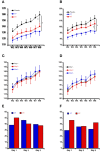Development of an Experimental Model to Study the Relationship Between Day-to-Day Variability in Blood Pressure and Aortic Stiffness
- PMID: 26696902
- PMCID: PMC4672044
- DOI: 10.3389/fphys.2015.00368
Development of an Experimental Model to Study the Relationship Between Day-to-Day Variability in Blood Pressure and Aortic Stiffness
Abstract
We aimed to develop an animal model of long-term blood pressure variability (BPV) and to investigate its consequences on aortic damage. We hypothesized that day-to-day BPV produced by discontinuous treatment of spontaneously hypertensive rats (SHR) by valsartan may increase arterial stiffness. For that purpose, rats were discontinuously treated, 2 days a week, or continuously treated by valsartan (30 mg/kg/d in chow) or placebo. Telemetered BP was recorded during 2 min every 15 min, 3 days a week during 8 weeks to cover the full BP variations in response to the treatment schedule. Pulse wave velocity (PWV) and aortic structure evaluated by immunohistochemistry were investigated in a second set of rats treated under the same conditions. Continuous treatment with valsartan reduced systolic BP (SBP) and reversed the aortic structural alterations observed in placebo treated SHR (decrease of medial cross-sectional area). Discontinuous treatment with valsartan decreased SBP to a similar extent but increased the day-to-day BPV, short term BPV, diastolic blood pressure (DBP), and PWV as compared with continuous treatment. Despite no modifications in the elastin/collagen ratio and aortic thickness, an increase in PWV was observed following discontinuous treatment and was associated with a specific accumulation of fibronectin and its αv-integrin receptor compared with both groups of rats. Taken together the present results indicate that a discontinuous treatment with valsartan is able to induce a significant increase in day-to-day BPV coupled to an aortic phenotype close to that observed in hypertension. This experimental model should pave the way for future experimental and clinical studies aimed at assessing how long-term BPV increases aortic stiffness.
Keywords: aortic stiffness; diastolic blood pressure; fibronectin; long-term blood pressure variability; pulse wave velocity; spontaneously hypertensive rats; telemetry.
Figures





Similar articles
-
SBP, DBP, and pulse blood pressure variability are temporally associated with the increase in pulse wave velocity in a model of aortic stiffness.J Hypertens. 2016 Apr;34(4):666-75. doi: 10.1097/HJH.0000000000000838. J Hypertens. 2016. PMID: 26938811
-
Withdrawal reveals lack of effect of prolonged antihypertensive treatment on intrinsic aortic wall stiffness in senescent spontaneously hypertensive rats.Clin Exp Pharmacol Physiol. 2002 Oct;29(10):898-904. doi: 10.1046/j.1440-1681.2002.03747.x. Clin Exp Pharmacol Physiol. 2002. PMID: 12207569
-
Association of Arterial Stiffness With Mid- to Long-Term Home Blood Pressure Variability in the Electronic Framingham Heart Study: Cohort Study.JMIR Cardio. 2024 Apr 8;8:e54801. doi: 10.2196/54801. JMIR Cardio. 2024. PMID: 38587880 Free PMC article.
-
Clinical measurement of arterial stiffness obtained from noninvasive pressure waveforms.Am J Hypertens. 2005 Jan;18(1 Pt 2):3S-10S. doi: 10.1016/j.amjhyper.2004.10.009. Am J Hypertens. 2005. PMID: 15683725 Review.
-
Effect of antihypertensive agents on arterial stiffness as evaluated by pulse wave velocity: clinical implications.Am J Cardiovasc Drugs. 2001;1(5):387-97. doi: 10.2165/00129784-200101050-00008. Am J Cardiovasc Drugs. 2001. PMID: 14728020 Review.
Cited by
-
Relationships between 24-h blood pressure variability and 24-h central arterial pressure, pulse wave velocity and augmentation index in hypertensive patients.Hypertens Res. 2017 Apr;40(4):385-391. doi: 10.1038/hr.2016.156. Epub 2016 Nov 24. Hypertens Res. 2017. PMID: 27881851
-
Differential Stiffening between the Abdominal and Thoracic Aorta: Effect of Salt Loading in Stroke-Prone Hypertensive Rats.J Vasc Res. 2018;55(3):144-158. doi: 10.1159/000488877. Epub 2018 Jun 8. J Vasc Res. 2018. PMID: 29886482 Free PMC article.
-
Nebivolol is more effective than atenolol for blood pressure variability attenuation and target organ damage prevention in L-NAME hypertensive rats.Hypertens Res. 2021 Jul;44(7):791-802. doi: 10.1038/s41440-021-00630-4. Epub 2021 Feb 22. Hypertens Res. 2021. PMID: 33612826
-
Blood Pressure Variability in Clinical Practice: Past, Present and the Future.J Am Heart Assoc. 2023 May 2;12(9):e029297. doi: 10.1161/JAHA.122.029297. Epub 2023 Apr 29. J Am Heart Assoc. 2023. PMID: 37119077 Free PMC article. Review.
-
Cross-sectional associations between short and mid-term blood pressure variability, cognition, and vascular stiffness in older adults.Cereb Circ Cogn Behav. 2023 Sep 1;5:100181. doi: 10.1016/j.cccb.2023.100181. eCollection 2023. Cereb Circ Cogn Behav. 2023. PMID: 37711969 Free PMC article.
References
-
- Bouissou C., Lacolley P., Dabire H., Safar M. E., Gabella G., Duchatelle V., et al. . (2014). Increased stiffness and cell-matrix interactions of abdominal aorta in two experimental nonhypertensive models: long-term chemically sympathectomized and sinoaortic denervated rats. J. Hypertens. 32, 652–658. 10.1097/HJH.0000000000000073 - DOI - PMC - PubMed
LinkOut - more resources
Full Text Sources
Other Literature Sources

